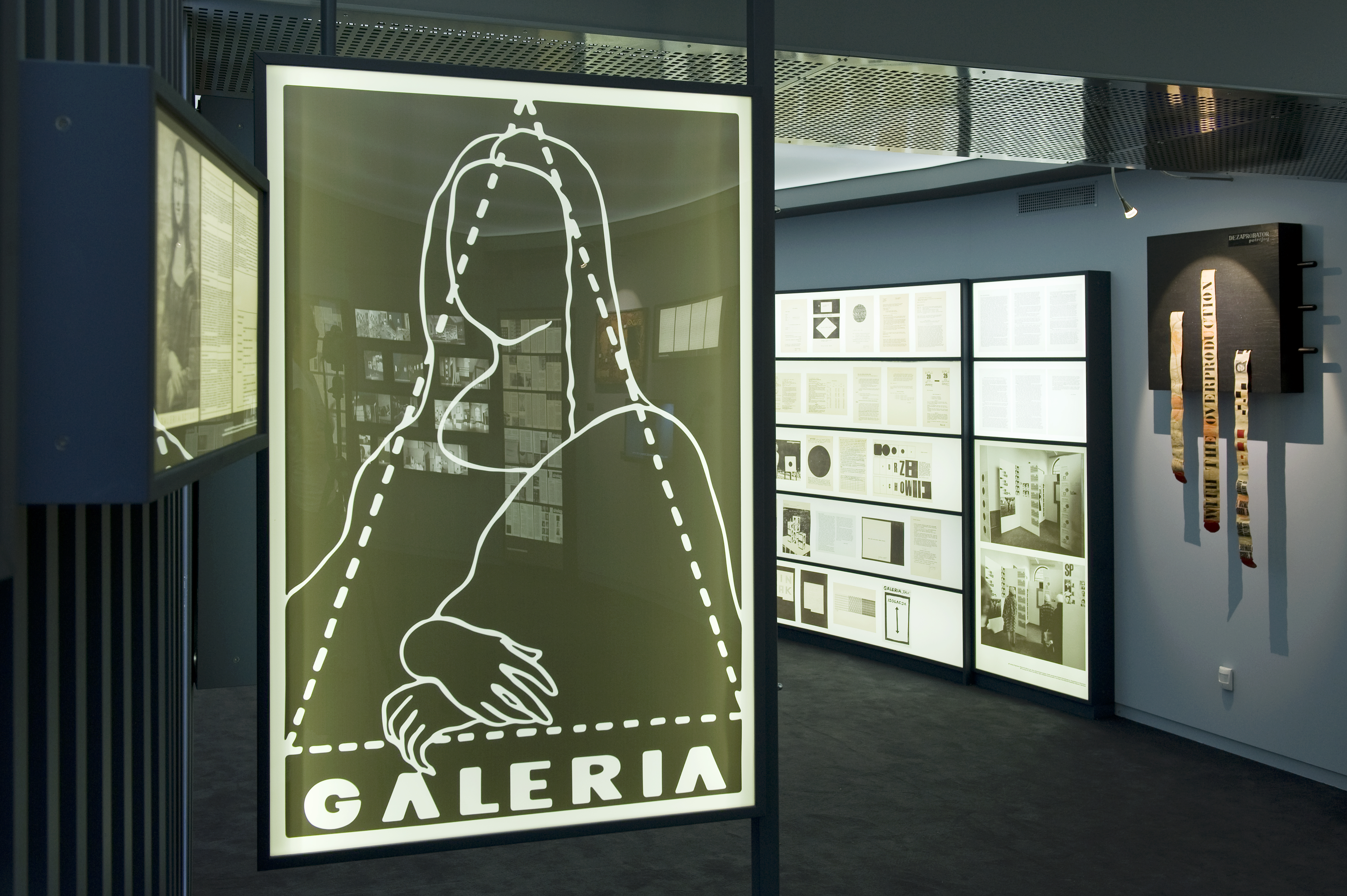Jerzy Ludwiński Archive, opened in 2013, is an effect of cooperation of two Wroclaw’s cultural institutions: the Contemporary Museum, founded in 2011, and the slightly older Zacheta Lower Silesian Fine Arts Association (established in 2004). The Archive is much more than just a permanent exhibition and a repository of the documents, artefacts and artistic objects connected to Ludwiński – ultimately it is supposed to serve the role of a research centre, focused on both the history of Polish art (especially Wroclaw’s neo-avant-garde), and on recognising and stimulating the development of modern art. Conceptually, the Archive refers to the idea of the Current Art Museum, formulated by Ludwiński in 1966. This idea served also as a basis for the program of the Wroclaw Contemporary Museum (MMW).
At the beginning Jerzy Ludwiński was associated with Lublin where he studied art history and co-founded the Zamek artistic group. In 1966 he organised the Artists’ and Scientists’ Symposium “Art in a changing world” in the Nitrogen Plants in Puławy – one of the most important events (besides the “Biennale of Spatial Forms” in Elbląg) in the development of conceptual art in Poland. The symposium, which confronted the artists, researchers and engineers from Pulawy’s plants, aimed to define the relations between the new art streams, technological progress, and the development of scientific thought. Later Ludwiński persistently put those dependencies in the centre of his interests, describing them i.e. in the famous text Art in a Post-Art Epoch from 1970, where he prophesied that the desire for dematerialising the art work (striving to focus on the process instead of objects), along with the technological and civilizational progress, will lead to the synergy of science and art, as well as to the dispersion of the artistic activity in an everyday life reality.
In 1966 Ludwiński moved to Wroclaw where he announced the concept of a Current Art Museum – an institution focused on researching new art tendencies, strengthening them, and entering into a critical dialogue with them. Ludwiński later developed this concept as a “museum of a game”, which referred to the mutual influence of a curator, an artist and an audience. The materialisation of those ideas took place in the Under Mona Lisa Gallery (pl. Galeria Pod Moną Lisą), which operated in a limited space of the International Press and Book Club’s hall between 1967-1971. Ludwiński based the program of the gallery on rejecting both the commemorative, annual and retrospective exhibitions, and the apparent democratisation of art – which was a reference to the fact that every creator holding a member card of the Association of Polish Artists and Designers was allowed to exhibit his or her works. Ludwiński categorically stated that he wanted to invite solely those artists who he considered valuable and innovatory – at the same time he didn’t want to resign from the fierce polemic. The gallery’s work plan composed of 3 elements: text, exposition, and discussion. The exhibition opening was preceded by a publication in the “Odra” magazine, which was a dialogue of a curator and an artist. For the exhibition closing a discussion panel was organised. Thus, the creators were forced to formulate their thoughts in writing and reacting to the voices of the critics and the audience. Furthermore, equally important was switching the focus from an artistic object to the creative process (Ludwińki’s term) and the bipolar reflection on modern art.
Ludwiński’s institutional critique, his curatorial strategies, and his engagement in decentralising and stimulating the art world (active participation in numerous panels, symposia, debates in whole country), became a basis for the Wroclaw Contemporary Museum (MMW), and especially for the Jerzy Ludwiński Archive. It was initiated by Piotr Lisowski – a young curator, then working in the Centre of Contemporary Art (CoCA) in Torun; an author of e.g. Filling the blanks exhibition, which was devoted to Ludwoński and his intellectual heritage. The organisation of a permanent exhibition in the Contemporary Museum was proposed by Dorota Monkiewicz, the first director of MMW. As a starting point for the Jerzy Ludwiński Archive served the collection – appearing under the same name – of the Zacheta Lower Silesian Fine Arts Association, which was given Ludwiński’s memorabilia and documents in 2008 by his wife, Małgorzata Iwanowska-Ludwińska, after his death in 2000 (some of the items were given to the Ujazdowski Castle Centre for Contemporary Art). Since the beginning MMW has also gathered its own archives, including the objects connected to Ludwiński and his close artistic circles. Thanks to that the Jerzy Ludwiński Archive is largely based on the MMW’s own collection. Among the artists, whose works or documentation is presented on the exhibition, are i.e. Jan Chwałczyk, Wanda Gołkowska, Henryk Stażewski, Natalia LL, and Włodzimierz Borowski. The arrangement refers to the methods of exposition used in the 1960s and the 1970s, which was designed by an artist Robert Rumas.
In 1975 Ludwiński moved to Torun where he had lived for the rest of his life (since 1982 simultaneously teaching in Poznan). However, he spent nearly a decade in Wroclaw which had a great influence on the shape of neo-avant-garde in Lower Silesia. The Jerzy Ludwiński Archive commemorates his legacy, as well as problematizes it, and places it in the current historical and artistic context. In spite of the fact that Ludwiński has never engaged in political issues, he was without a doubt a person contesting the cultural institutions’ conventions and the standards of the dominant culture – which was proved by his critique of the artistic institutions, struggle for decentralising the art field, persistent confronting the critics, artists and audience, his visionary perception of changes within art, as well as his somewhat hippie lifestyle.
Sources:
Dzikie pola. Historia awangardowego Wrocławia, Dorota Monkiewcz (ed.), Zachęta – Narodowa Galeria Sztuki, Muzeum Współczesne Wrocław, Warsaw 2015.
Jerzy Ludwiński. Wypełniając puste pola, Piotr Lisowski, Katarzyna Radomska (ed.), Centrum Sztuki Współczesnej Znaki Czasu, Toruń 2011.

